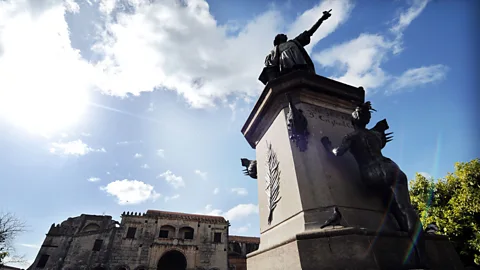
Columbus’s personal timeline has been so enigmatic that both Seville, Spain and Santo Domingo, Dominican Republic lay claim to the explorer’s remains.
It’s hard to believe
that a historical figure whose life was so well documented could still be shrouded
in mystery. But the famed explorer Christopher Columbus’s personal timeline has
been so enigmatic that across Europe, scientists, historians and everyday
people with an interest in the past are still searching for the truth behind
his legacy.
For example, we know
where and when Columbus died — in the northwestern Spanish city of Valladolid,
in 1506 — but there are questions about where his body lies. For decades, the
Spanish city of Seville has argued with the capital city of the Dominican
Republic, Santo Domingo, over which can lay claim to Columbus’s burial site.
And with good reason: Columbus’s remains were moved at least three or four times over the course of 400 years. The
distances were great, too. From Valladolid, his bones were moved in 1509 to the
Monasterio
de la Cartuja, a monastery near Seville that can still be visited today. Then,
in 1537, his daughter-in-law moved his remains (along with those of her dead
husband) to the Catedral
Primada de America in Santo Domingo – perhaps because, some historians
believe, Columbus wanted to be buried in the New World. More than 250 years
later, when Spain ceded Hispaniola (a region encompassing the Dominican
Republic and Haiti) to France in 1795, his bones took yet another journey to
keep him within Spanish possession, this time to Havana, Cuba. They stayed
there for about 100 years until the Spanish-American War in 1898, when they
were transferred back to Seville, to the Catedral de Sevilla.
During all that, it’s
possible that Columbus’s bones were mixed up with someone else’s — which is
what some Dominicans argue, pointing to a discovery in 1877 of a tomb-like chest
in the Santo Domingo cathedral with an inscription reading, “Illustrious and
distinguished male, don Cristobal Colon”.
There has been some
clarification in recent years, however, thanks to advances in DNA testing. In
2006, according to
the Associated Press,
Spanish researchers took DNA from bones in Seville that are purported to be
Columbus’s and compared it with DNA from the bones known to be those of his
brother, Diego, also located in Seville. The samples turned out to be a match,
though researchers pointed out that this
strong evidence does not completely rule out the possibility of the bones in
Santo Domingo also belonging to the explorer.
Equally murky is the
matter of Columbus’s nationality. Theories vary as to whether the voyager was
Italian, Spanish, French, Polish, Portuguese… the list goes on. Another 2006
study, carried out by some of the same geneticists who looked into Columbus’s
death, sought to
use DNA once more to
solve this second mystery. The bulk of historical evidence points to Columbus
being either Spanish or Italian, so the researchers started there. Since the
name Columbus is actually “Colon” in Spanish and “Colombo” in Italian, they
gathered DNA samples from hundreds of men with these last names – because both
their surnames and their Y chromosomes would be passed down from their fathers.
Unfortunately, the
results were inconclusive. But another researcher, this time an American
linguistics professor, took on the task of examining Columbus’s origins using a
completely different approach. Estelle Irizarry scrutinized the
man’s writings — in letters and other documents — in an attempt to figure out
what his native language truly was. Her assessment was that although Columbus
wrote in Spanish (the majority Spanish dialect), it was not his first language.
Instead, she believes his grammar and sentence construction indicate that
Catalan was his native language, and he would have been from what was then the Kingdom
of Aragon in northeastern Spain.
Still,
Italians who believe they share heritage with Columbus would argue that language
does not tell the whole tale. Indeed, even with a mix of historic, scientific
and linguistic research, the story of the explorer’s personal geography may
never find completion. It is an unsolved puzzle that adds even more intrigue to
an already controversial figure in history, inspiring travellers to delve
deeper into his life in both Europe and the Americas.



